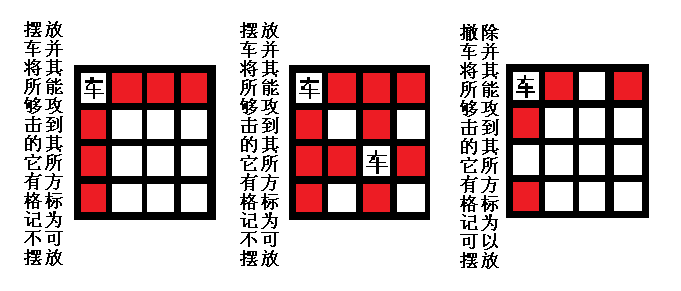POJ1315:Don't Get Rooked
点击打开题目链接
====================================题目大意======================================
在一个有着可以阻碍攻击的墙的棋盘上摆放车,使其相互之间不能攻击,输出能够摆放车的最大数量。
=====================================算法分析=====================================
题目数据水,只要DFS+回溯写对了怎么着都能过。但是这里面有一个不得不说一下的优化。
当判断一个方格中能不能摆放车时,一般的方法是搜索能够攻击到这个方格的其他所有方格中有没有車,但这会造成很多的重复
搜索。
事实上,在摆放车的时候直接将其能够攻击到其它所有方格标记为不可摆放不就行了?
定义一个对应地图的布尔数组HashMap来标记方格。
定义一个函数UpdateHashMap(Row,Col,Val)来将位于方格(Row,Col)中的车能够攻击到的其他所有方格的HashMap值设为Val。
在摆放车的时候调用UpdateHashMap(Row,Col,1),在回溯的时候调用UpdateHashMap(Row,Col,0)。
就可以直接通过方格对应的HashMap值是否为0来判断其是否可以摆放车了。
我一开始就是这么做的,结果提交WA了,后来想了想才发现出错的原因,举个出错的例子。
出错的原因很简单,一个车在撤除自己的攻击影响时撤除了其他车的攻击影响。解决方法也很容易想到:
将HashMap改为整形数组,将函数UpdateHashMap(Row,Col,Val)的作用改为将位于方格(Row,Col)中的车能够攻击到的其他所有方格
的HashMap值加Val。
在摆放车的时候调用UpdateHashMap(Row,Col,1),在回溯的时候调用UpdateHashMap(Row,Col,-1)即可。
=======================================代码=======================================
![]()
#include<stdio.h>
const int Dir[4][2]={{0,-1},{0,1},{1,0},{-1,0}};
int N,Ans,HashMap[10][10];
char Map[10][10];
void UpdateHashMap(int Row,int Col,int Val)
{
for(int n=0;n<4;++n)
{
int tmprow=Row;
int tmpcol=Col;
while(1)
{
if(!(0<=tmprow&&tmprow<N)) { break; }
if(!(0<=tmpcol&&tmpcol<N)) { break; }
if(Map[tmprow][tmpcol]!='.') { break; }
HashMap[tmprow][tmpcol]+=Val;
tmprow+=Dir[n][0];
tmpcol+=Dir[n][1];
}
}
}
void DFS(int Row,int Col,int ChessNum)
{
if(Col==N)
{
++Row; Col=0;
}
if(Row==N)
{
Ans=(Ans>ChessNum?Ans:ChessNum); return;
}
if(Map[Row][Col]=='.'&&!HashMap[Row][Col])
{
UpdateHashMap(Row,Col,1);
DFS(Row,Col+1,ChessNum+1);
UpdateHashMap(Row,Col,-1);
}
DFS(Row,Col+1,ChessNum);
}
int main()
{
while(scanf("%d",&N)==1&&N)
{
Ans=0;
for(int i=0;i<N;++i)
{
scanf("%s",Map[i]);
}
DFS(0,0,0);
printf("%d\n",Ans);
}
return 0;
}

